Tampa’s history in pro wrestling played vital role in developing superstars – past and present

From 2006: Tampa is Wrestletown U.S.A.
The past, present, and future of Tampa’s role in wrestling history are tied together. Eddie Graham in the '60s, the Brisco Brothers in the '70s. There was also Macho Man and, of course, Hulkmania.
TAMPA, Fla. - Tampa's wrestling history is like no other, and has more than once been a springboard for developing superstars. Since the 1960s, many household names in the industry have called Tampa Bay their home.
Before Vince MacMahon's World Wrestling Entertainment was formed, the wrestling world looked a lot different. Decades ago, wrestlers competed in different regions of the country, and Tampa was one of those home bases under the name "Championship Wrestling in Florida."
Big names in the wrestling world thrived in the city -- like Hulk Hogan and Dusty Rhodes. Tampa was where stars once competed with each other in front of cheering fans inside the former Fort Homer Hesterly Armory.
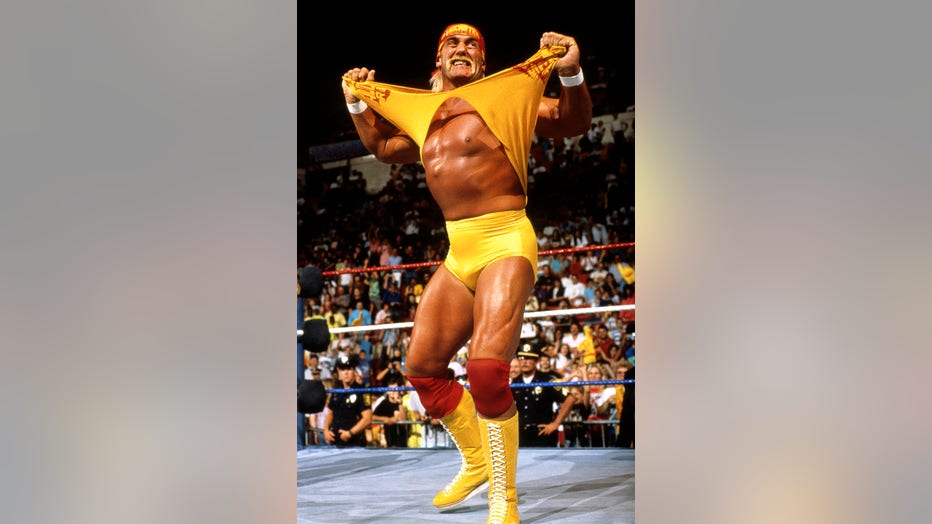
Photo of Hulk Hogan captured in 1991. (Courtesy: WWE)
Fast forward to today, when the WWE dominates the business. Knowing Tampa's legacy makes it even more surprising that it took 37 years for the city to finally host a WrestleMania, the biggest pro-wrestling event in the industry.
The late Mike Graham, a professional wrestler who was born in Tampa, once told FOX 13, "To this day, nobody has turned out any better, more successful long-term wrestlers than we did."

From 2018: Tampa resident Dave Bautista shows off his collection
Former WWE superstar turned actor Dave Bautista invited FOX 13 to his Tampa home to talk about his role in the ‘Avengers: Infinity War’ film.
Television gives rise to wrestling
Wrestling itself wouldn’t truly have become popular without television, which played a role in the rise and downfall of the regional wrestling system and, later on, helped McMahon nationalize the pro-wrestling business to bring superstars into living rooms across America.
While Tampa hosted some wrestling matches in the early 1900s, it didn't really get popular until people started purchasing television sets, explained Dr. Brad Massey, the curator of public history at the Tampa Bay History Center.
"Once that happens, the business of wrestling really gets ratcheted up," he told FOX 13. "It’s going to be broadcast in people’s homes, and wrestlers are going to become household names."

Color television sets weren’t initially used for entertainment but as a tool for surgeons and medical students, according to the Smithsonian. The FCC didn’t approve the use of commercial color television systems until the start of the 1950s. (1953 ph
As more Americans get television sets from the 1950s to the 1970s, Florida's population explodes at this time too, Massey added.
"Before WWII, Florida is the smallest southern state in terms of population," he explained. "But, you know, thanks to air conditioning and Social Security and America’s changing economy -- all of sudden all these people start to move to Florida. Of course, one of the places that they move to is going to be Tampa."
The Tampa market was a region that Eddie Graham and wrestling promoters tapped into. Thus, the Championship Wrestling from Florida organization was born and thrived.
"It becomes really popular in Florida," Massey said, "because it’s a marketable product and the population in the state is increasing so fast."
NWA: The beginning
The National Wrestling Alliance was founded in 1948 and still exists today, but not as the governing body that it once was.
Back then, and before its creation, there were regional wrestling promotions across America. By 1948, a man by the name of Paul "Pinkie" George founded NWA, along with other promoters.
The goal was to consolidate those regional companies and divide up the promotions into territories under the NWA brand. One of which was Championship Wrestling from Florida, based out of Tampa.
The NWA had a World Heavyweight Champion, who would travel to territories to defend the title against the top pro-wrestlers across different regions.
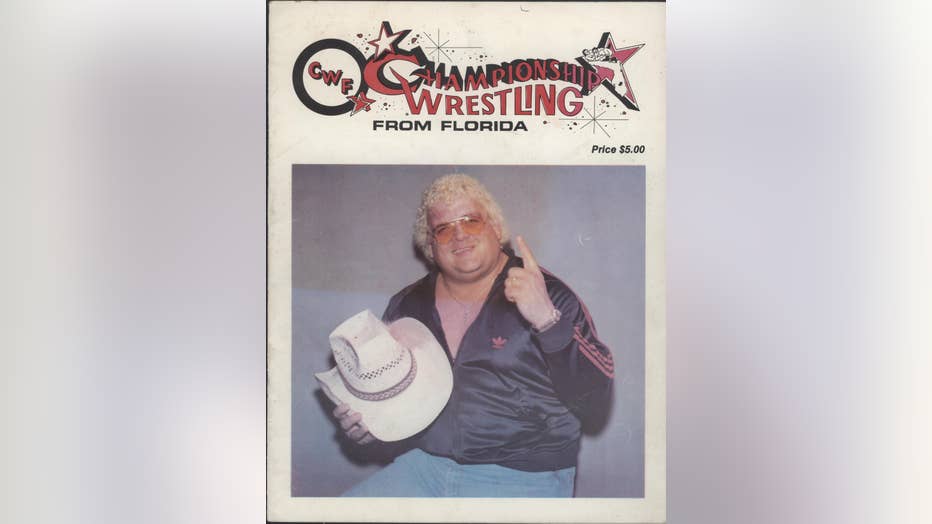
Championship Wrestling from Florida logo with wrestler, Dusty Rhodes. (Courtesy: Tampa Bay History Center)
Following the invention of television, these professional wrestling matches were being aired, reaching more fans than before.
"Then what promoters figure out really quickly is the audience is more interested in and it’s easier to sell what’s called 'worked matches,'" Dr. Massey explained. "These were matches that were choreographed."
Massey acknowledged WWE star Ric Flair's famous quote about wrestling, "It isn’t fake. It’s choreographed."
"And he’s right," Massey said. "What they figure is that if they control the time, if they can control the action, they can make a more marketable product."
Compared to other sports like baseball, wrestling was easier to capture with early TV technology, he explained.
"You can just point the camera at the ring," Massey said. "This is difficult when it comes to baseball and football. When people have TVs, wrestling is one of the first sporting events that they are going to see in their living rooms."
CWF: "So long from the Sunshine State"
Between the 1950s and 1980s, the regional system was the dominant structure in the industry. One of those territories was the Tampa-based CWF.
"The way it worked was Championship Wrestling from Florida was one of the stops on the circuit. You travel the circuit. You go to the different markets and you wrestle," Dr. Massey said. "A lot of wrestlers liked to come into Florida because the pay was good. There were a lot of opportunities to get exposure."

Born as Edward Gossett in Tennessee back in 1930, the CWF promoter helped ring in some professional wrestler who remain in the industry today. (Courtesy: Tampa Bay History Center)
Wrestler Eddie Graham bought the promotion back in 1961. From then until the 1980s, CWF matches were aired in the living rooms across the Sunshine State.
During the CWF years, there were plenty of personalities that came through, including Dusty Rhodes. Many wrestlers tried to challenge Rhodes -- knowing he was popular among fans -- to make their own name in the CWF territory.
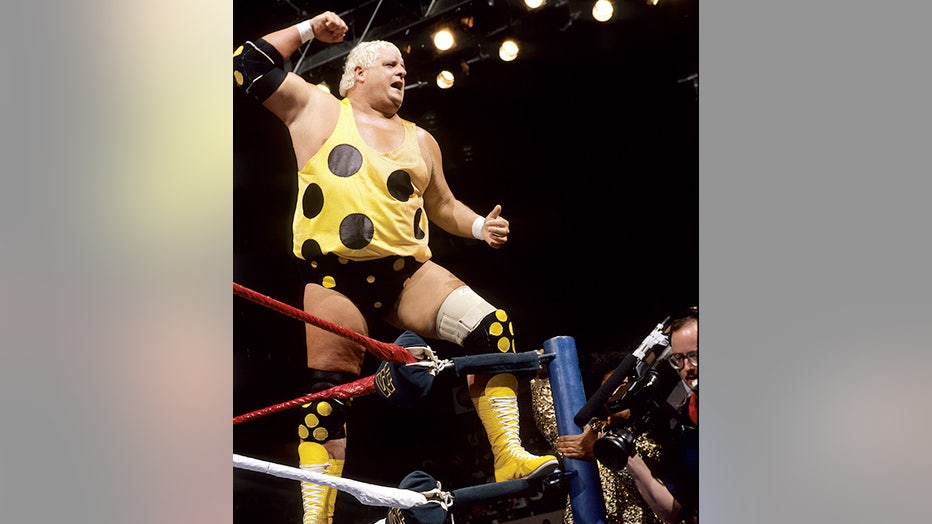
Dusty Rhodes when he wrestled for the WWE. Before that, he wrestled in the territory system, including within the CWF. (Courtesy: WWE)
While there were -- and still are -- some household names that came through the CWF, there was also the "voice" behind the territory: Gordon Solie, who was a play-by-play wrestling announcer. He hosted CWF matches for 27 years.
His signature sign-off was, "So long from the Sunshine State."
Solie passed away at the age of 71 at his New Port Richey home in July 2000 after succumbing to brain cancer.

Gordon Solie interviews woman during an NWA match in Key West on August 23, 1979. (Courtesy: Cory McDonald/Florida State Archives)
"Tampa is important because of the wrestling circuit here in Tampa and for Championship Wrestling from Florida is going to be the Armory," Dr. Massey explained. "That’s where Gordon Solie is going to do his famous ringside commentary."
Tampa’s Fort Homer Hesterly Armory -- which is listed on the U.S. National Register for Historic Places -- still stands today along North Howard Avenue, but is now the Bryan Glazer Family Jewish Community Center.
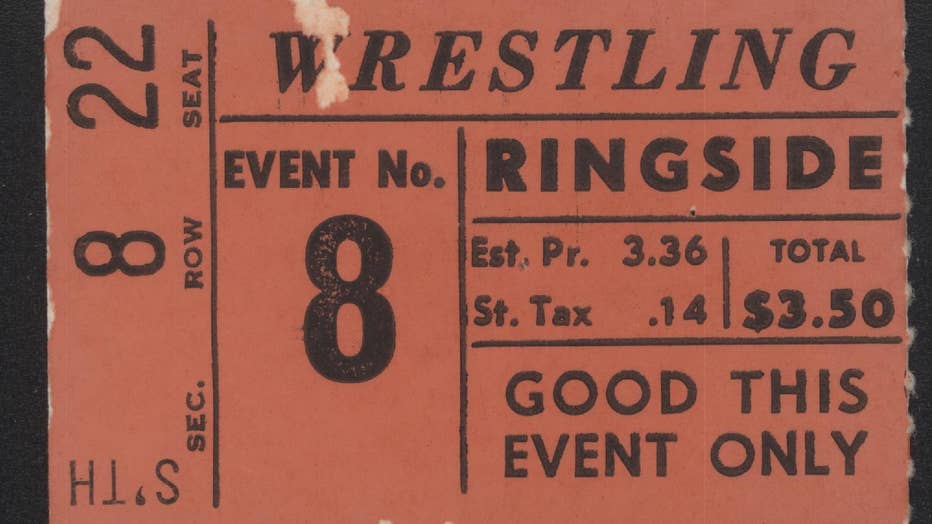
Ticket stub to a wrestling match at Tampa's Fort Homer Hesterly Armory. (Courtesy: Tampa Bay History Center)
Wrestlers at the time were rotated through different regions. Tampa-based trainers like Hiro Matsuda groomed people like Hulk Hogan to perform at the Armory.

From 2015: Memories reside inside the Armory
Decades ago, pro-wrestlers would compete with all their heart inside the Fort Homer Hesterly Armory, including legends like the late Dusty Rhodes and Rocky Johnson, father of Dwayne ‘The Rock’ Johnson.
"Tampa’s really this place that puts out a lot of these professional wrestlers," Massey said, "and it has ties to wrestlers in different ways."
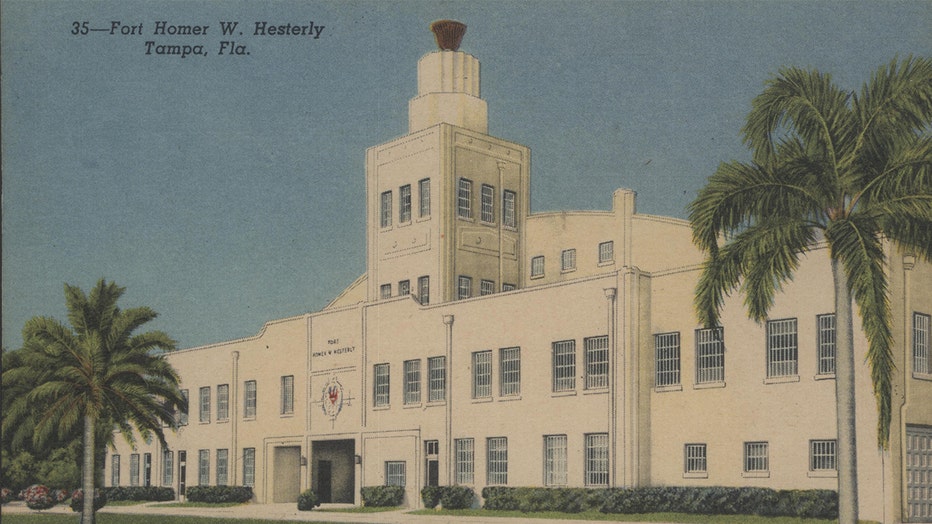
Fort Homer W. Hesterly Armory (Courtesy: Tampa Bay History Center)
Enter the McMahon family
The NWA was the largest governing body in the industry, but its territory system began to falter after nearly 40 years of dominating the business. By the 1980s, fans were exposed to the inconsistent storylines between the regional organizations due to cable television.
"I mean with Championship Wrestling from Florida, you’re only going to see it if you’re watching TV in the '70s and you’re in the Florida market," Dr. Massey explained. "We see this movement of television programs as they become more nationalized."
In the early 1980s, Vince McMahon began to change the game, and his moves made a significant impact in Florida's wrestling environment.
In 1982, he acquired the operations of Capitol Wrestling Corporation from his father, who died two years later. CWC oversaw the World Wrestling Federation, which would later become WWE in 2002.
By 1983, McMahon took notice of the dying regional product and left NWA to turn his northeastern U.S. territory into the first national promotion of pro-wrestling. He began to transform WWF's programming into syndicated television across the country.

Vince McMahon, during his time at the WWF. January 01, 1993. (Photo by Michael Norcia/New York Post Archives /(c) NYP Holdings, Inc. via Getty Images)
"Vince McMahon never has a true monopoly on wrestling but he’s able to sign away the talent and he’s able to end the circuit system and really kind of center the profits in his own nationalized market," Dr. Massey explained. "You just see the end of regionalism."
"That will coincide with the rise of particularly Hulk Hogan," he added, "and the Macho Man Randy Savage, and then some of the other well-known wrestlers like Chyna."

From 2016: WWE star Chyna dies
She's known as the 9th Wonder of the World. Joanie Laurer, AKA Chyna, would become one of the biggest female wrestling stars in history. The University of Tampa alumna's sudden death in 2016 sparked tributes from former colleagues.
The Brisco Brothers: Tag Team Champions
Gerald Brisco and his older brother, Jack, both wrestled in different NWA territories, including in Florida. Together, they became a formidable tag team and won dozens of championship titles.
Jack -- a fews years older than Gerald -- was the first of the two to begin his wrestling career. He was described as a "standout amateur wrestler" and joined the team at Oklahoma State University in the late 1960s. He was the first Native American to win the NCAA Wrestling Championship back in 1965.
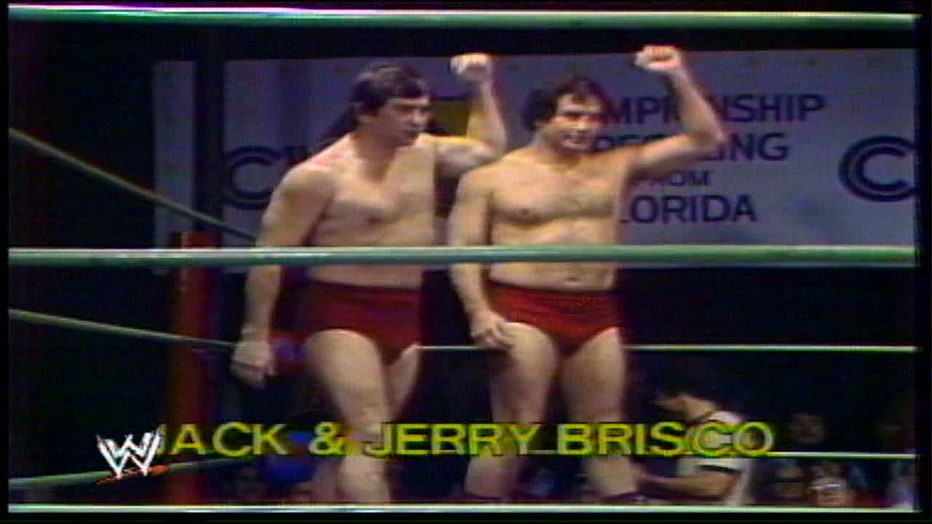
The younger Brisco also wrestled at OSU.
Jack won the NWA Missouri Junior Heavyweight Championship twice in one year, and was successful during his time in the CWF. He won several regional championships in Florida before a brief stint in Japan.
Jack returned to the NWA with his brother, Gerald, who he trained to be a professional wrestler. That's when the duo made a name for themselves, winning several tag team titles, especially in the CWF where they won the Florida tag titles eight times.
Even individually, they won their own titles. Jack held a World Champion title and Gerald won the Southern Heavyweight and Florida Heavyweight Championships.

From 2010: Jack Brisco’s memorial
Jack Brisco -- one-half of the tag team ‘Brisco Brothers’ -- passed away in 2010. At the time, he was a resident of Tampa Bay.
In the 1970s, they discovered Hulk Hogan and referred him to Matsuda, the trainer.
In 1984, the brothers acquired controlling interests in the Georgia Championship Wrestling territory and sold it to Vince McMahon. They were, once again, fan favorites during their time with the WWF, which later became WWE.
In 2008, the Brisco Brothers were inducted into the WWE Hall of Fame.
In 2010, Jack passed away after suffering from heart disease.
For over three decades, Gerald worked behind the scenes of WWE, but was released in 2020 from his job as a talent scout. He currently calls the Tampa Bay area his home.
Homegrown: "Hulkmania is running wild, brother"
One of the more well-known local wrestlers is none other than Hulk Hogan, whose real name is Terry Bollea.
"Hogan literally grows up here, he’s a product of the Bay Area. Everybody knows him," Dr. Massey said. "If you’ve lived here long enough, you’d usually run into him around town."
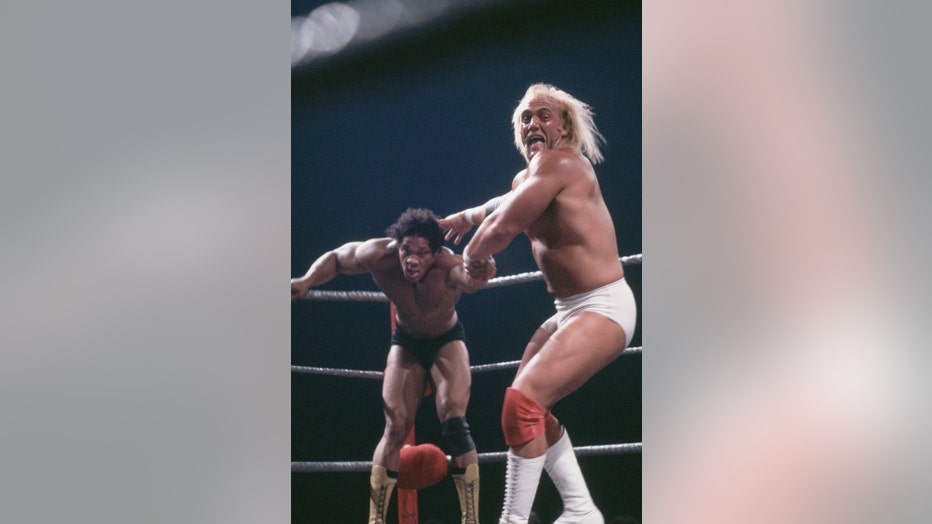
Hulk Hogan and Tony Atlas in the Ring (Photo by © Wally McNamee/CORBIS/Corbis via Getty Images)
His family moved from Georgia to Tampa when he was a toddler. He attended Robinson High School, enrolled at Hillsborough Community College and later become a Bull at the University of South Florida. He dropped out before earning a music degree.
Bollea was part of many bands, and performed in local clubs where wrestlers frequented. It was then that the Brisco Brothers introduced him Hiro Matsuda.
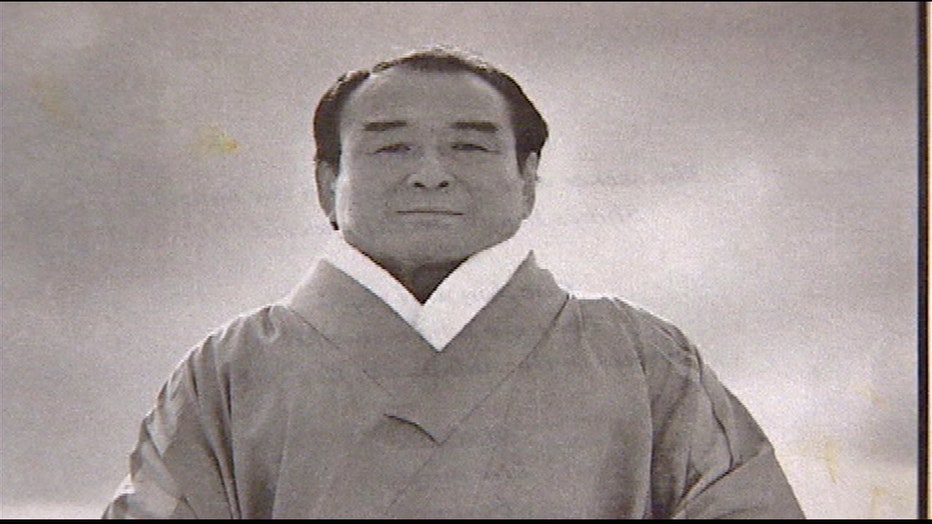
File image of Hiro Matsuda
Eddie Graham booked Bollea's first match in Fort Myers back in 1977. Eventually, he took a hiatus from CWF, but later rejoined the business and ended up back in the circuit and wrestled in other territories outside of Florida.
Bollea's earlier stage names were Terry Boulder, Super Destroyer and Sterling Gordon. He took on "The Hulk" title when he went on a talk show with Lou Ferrigno, who played in The Incredible Hulk television show. It was quickly noticed that Bollea was larger in size than Ferrigno.
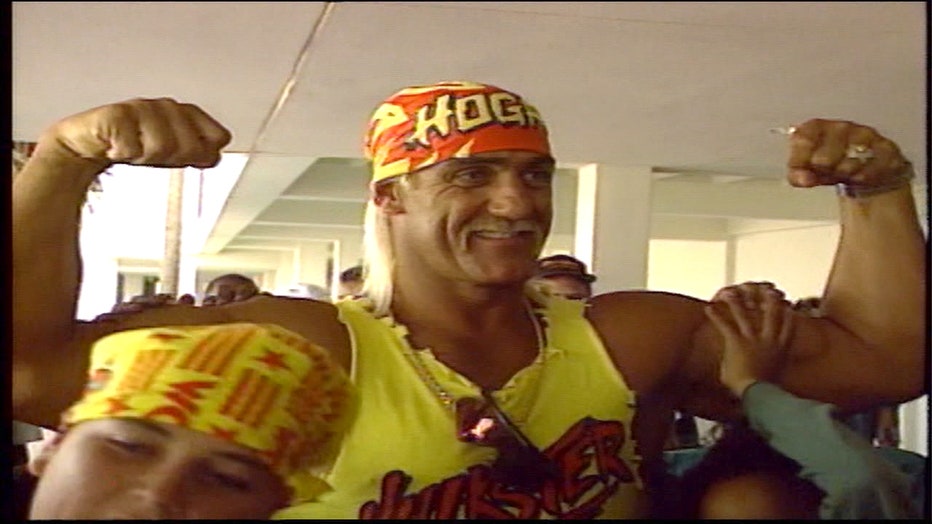
In 1979, he was introduced to the owner of the World Wrestling Federation -- Vincent J. McMahon, the father of the current WWE owner. Bollea joined the organization.
It was then that McMahon wanted Bollea to adopt last name, "Hogan," and his rise in fame grew under the household name. He was featured in the very first WrestleMania on March 31, 1985.
Eddie Graham, legendary promoter
Edward Gossett -- also known by his stage name, Eddie Graham -- was not only a professional wrestler, but he was credited with helping the CWF thrive as the promoter.
At 17 years old, he began his training for a wrestling career and competed in Texas for another decade. He even joined the Capitol Wrestling Corporation promotion, which served the Northeast and owned by Vincent J. McMahon.
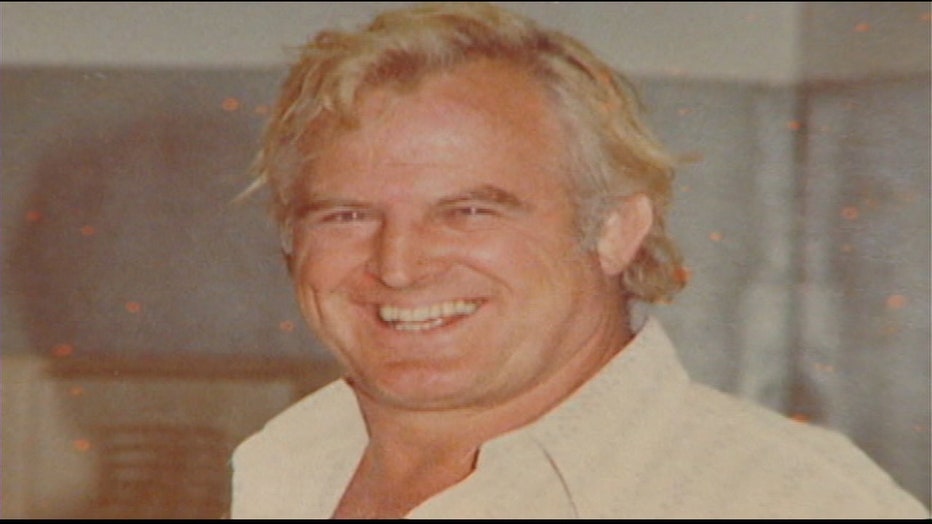
Born as Edward Gossett in Tennessee back in 1930, the CWF promoter helped ring in professional wrestlers who remain in the industry today.
In 1960, he headed to Florida to wrestle and took over as the CWF promoter in 1971. He continued to wrestle and won numerous championships, including the NWA Florida Tag Team Championship with partners like Bob Orton Sr., Jose Lothario, and his son, Mike.
Eddie eventually retired in 1977 due to health problems.
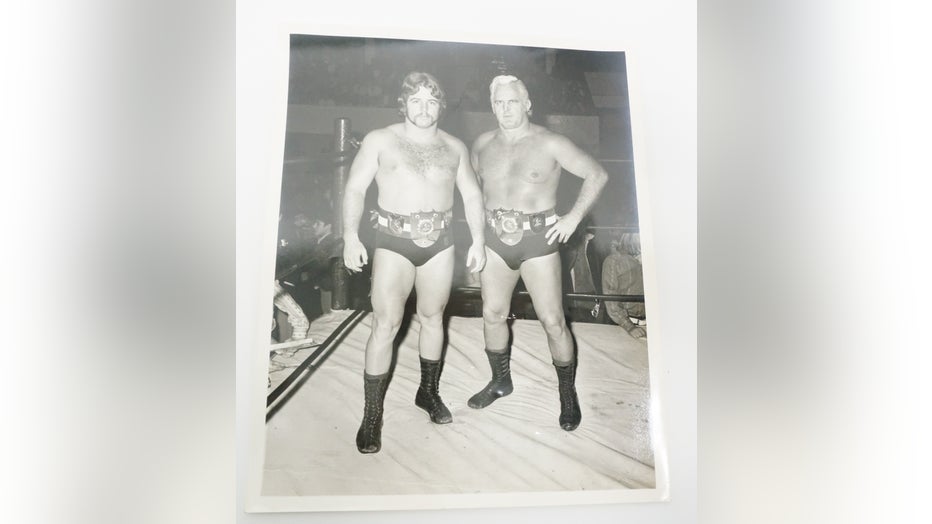
Mike Graham (left) and his father, Eddie Graham (right). (Courtesy: Tampa Bay History Center)
Graham remained in Florida as the promoter in the years that followed. He later died by suicide in 1985.
In 2008, the WWE inducted him into the Hall of Fame posthumously by Dusty Rhodes, one of Graham's former employees. Mike Graham accepted the honor on his behalf.
Dusty Rhodes, the "American Dream"
Born as Virgil Riley Runnels, Jr., "Dusty Rhodes" was a professional wrestler who worked in the NWA and also made his way to the WWE.
He was known to not have a typical wrestling physique, but he was more known for his rags-to-riches character and was deemed the "American Dream" or "son of a plumber" -- and with a personality that shined. WWE says his most famous quote was, "I have wined and dined with kings and queens, and I’ve slept in alleys and dined on pork and beans."
He broke out as a wrestler following a 1974 match in the CWF against Eddie and Mike Graham.
"From Florida to New York City, crowds lined up to see Rhodes deliver his Bionic Elbow to rivals like Harley Race, Ernie Ladd and 'Superstar' Billy Graham," according to his WWE bio.
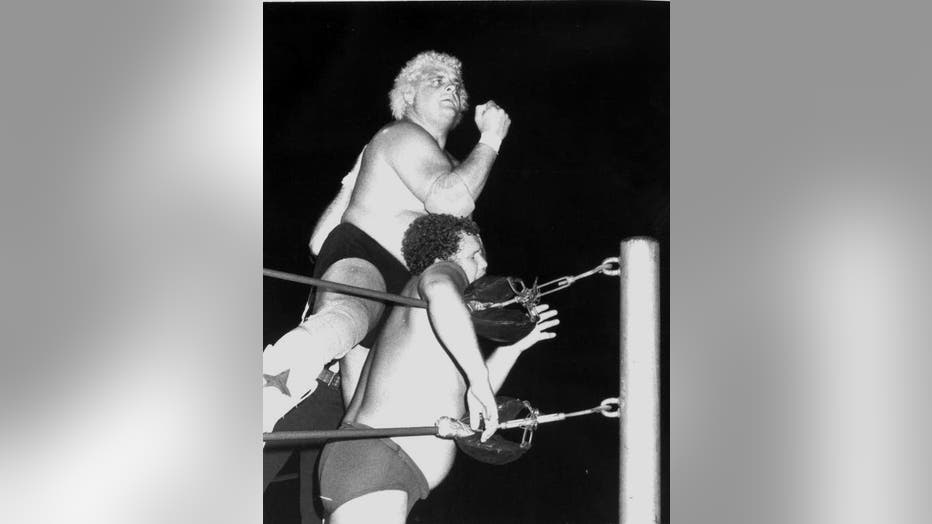
Photographed on August 23, 1979, Dusty Rhodes is seen giving the "Bionic Elbow" to Harley Race during their NWA wrestling match in Key West. (Courtesy: Cory McDonald/Florida State Archives)
He held the NWA championship title three times. After retiring from the ring, he remained a fixture with the WWE and worked at the performance center in Orlando.
Runnels was the father of two other wrestlers: Dustin and Cody Runnels.
He was inducted into the WWE Hall of Fame in 2007. In July 2015, he passed away.
Dustin has since opened a wrestling academy in Austin -- Virgil's hometown.
FCW: Live from...Dale Mabry Highway
In 2007, the WWE launched Florida Championship Wrestling in Tampa as a developmental program for potential WWE wrestlers -- and, yes, there is a reason why its name sounds similar to the CWF name.
Steve Keirn was a professional wrestler who joined the CWF, working for Eddie Graham back in 1972, and later on, joined the WWE. He competed in the ring for two WrestleMania events before retiring and started educating himself on how to pass on his knowledge to wrestling hopefuls.
The stars aligned, and the WWE decided to close their other developmental territories in the U.S. and opened one in Florida -- more specifically, Tampa. Keirn was the man they chose to operate. In a WWE documentary titled, "A Future WWE: The FCW Story," the organization said they believed Florida would attract more high-profile athletes.

From 2006: Florida Championship Wrestling prepares to train WWE hopefuls in Tampa
FOX 13's Lloyd Sowers previewed the new FCW facility in this 2006 report.
Keirn said he decided to used his past experience to choose a name from the program.
"I recreated what I had started with. I started with Championship Wrestling from Florida," he said in the documentary. "The first thing was a name. I said, 'Well, I don’t want to use an old name.' So, I came up with – really creative here right – Florida Championship Wrestling."
It officially launched in 2007, with about 20 talent at the time, at a place called Hitmaster Sports along Hillsborough Avenue. Eventually, the FCW moved to a primary location -- 4535 South Dale Mabry -- for the next six years, which was part of a storage warehouse.
Aspiring wrestlers at the time recalled seeing pallets of peas along with processed and canned foods around the building. Today, Playgrounds of Tampa operates in the former FWC warehouse.
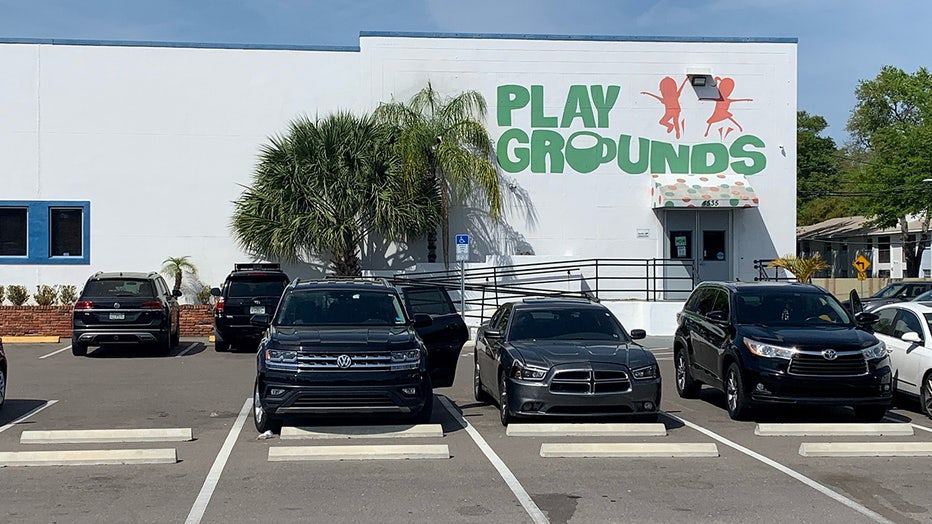
Playgrounds of Tampa, an indoor bounce house, is located where the FCW Arena used to be. (File image/FOX 13)
The top wrestling trainers were brought in during that time, including Dusty Rhodes, who was described by the trainees as a mentor.
"Tampa is not the only place that has wrestling schools, but early on it is a place where some of the most well-known trainers based their schools and their operations," Dr. Massey explained to FOX 13. "I think that attracts wrestlers to this area and then, I think when you have a wrestling culture as long as has, you have people that grow up in this area and they're motivated by seeing Championship Wrestling from Florida."
The FCW was evidence of that. The developmental program brought in aspiring wrestlers who are household names in the WWE.
Just to name a few: Charlotte Flair, the Bella Twins, Natalya, Tyson Kidd, Seth Rollins, Sheamus, Titus O'Neal, Drew McIntyre, Baron Corbin, Kofi Kingston, Bayley, Roman Reigns, and Big E, who was born and raised in Tampa.
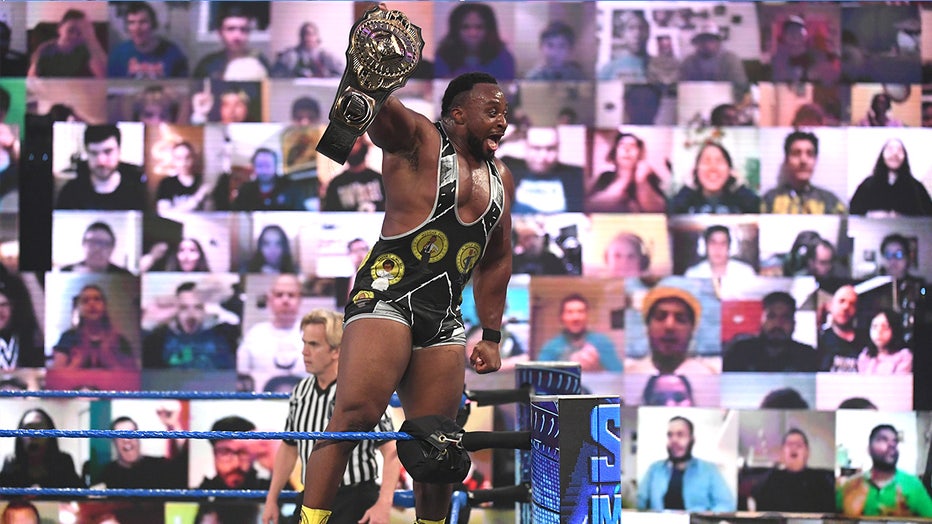
Big E, or Ettore Ewen, is a WWE wrestler who worked his way through the FCW before signing with the WWE. He was born in Tampa and attended Wharton High School. (Courtesy: WWE)
The trainees would travel to different Florida cities -- like Starke and Daytona Beach -- to practice in front of a live audience. They were not just performing though. They also had to clean up and break down rings before and after each show.
They wrestled in parking lots, flea markets, the Florida Strawberry Festival and Bourbon Street, a bar in New Port Richey. They were even at a venue where a wedding ceremony was taking place next door.
"You learn everything from the ground up," Natalya said in the documentary. "It gives you even more appreciation for what we do."
One year after FCW started, they launched a live show that would only broadcast at homes in the region. It was an opportunity for trainees to learn how to time cues and work the cameras. It was not just a training ground for aspiring wrestlers, but also for referees, announcers, cameramen, and producers too.
The first premiere episode taped on July 17, 2008 from the Dale Mabry warehouse. Admission was about $5. Popcorn and refreshments were $1.
Keirn was once again inspired by his CWF roots, and made sure to include Gordon Solie's famous parting words at the end of each FCW broadcast, "So long from the Sunshine State."
Before FCW came to an end, NXT was launched as a TV show under the WWE umbrella. It was rebranded in 2012, replacing FCW's system. The move came after Triple H was named WWE's executive vice president of talent, live events, and creative in 2011.
The FCW warehouse was closed in 2013, relocating its developmental activities to Orlando where the WWE Performance Center opened its doors later that year.
The new center was a multimillion-dollar facility, with a gym, medical room, upstairs lobby and kitchen. Keirn decided against relocating, but thought the move was a good idea, he said in the WWE documentary.

From 2019: WWE Performance Center gives tools to future wrestlers
Most wrestling fans will never step foot inside the WWE Performance Center in Orlando, Florida, but FOX 13 was granted special access to the state-of-the-art training center so we could show you what it's like to train with the WWE superstars.
PREVIOUS COVERAGE: WWE Performance Center: Superstars rise in Orlando
Many of the trainees described FCW as a "grassroots" movement and that first step that led to NXT, which ultimately is a third brand of the WWE, along with Monday Night Raw and Friday Night SmackDown.
"It was clear that there was a real investment in NXT and the future and that the company took that very seriously," Big E said during the FCW documentary. "But in the same vein, you know, I have a soft spot in my heart for FCW, for that little warehouse."
"It’s something that’s just a little bit more organic," he added. "I guess for me, that’s just a bunch of young kids trying to make it in this hot environment and I feel like there’s a beauty in that greatness. Obviously, the [Performance Center] is the next level. That’s the future."

From 2020: Wrestling community remembers Rocky Johnson
Back in 2020, Rocky's son, Dewayne The Rock Johnson, announced that it was a blood clot that took his father's life on Jan. 15. Rocky Johnson was a Tampa Bay resident.
Finally, WrestleMania comes to Tampa
Today, the WWE is the largest wrestling organization in the game, with many of its superstars living and working in Tampa Bay. In fact, Hillsborough residents even elected one of them to be a county commissioner, Brian Blair.
"I can tell you is that the WWF, which then becomes the WWE, does a good job consolidating wrestling," Dr. Massey explained. "Although, it does have some competitors."
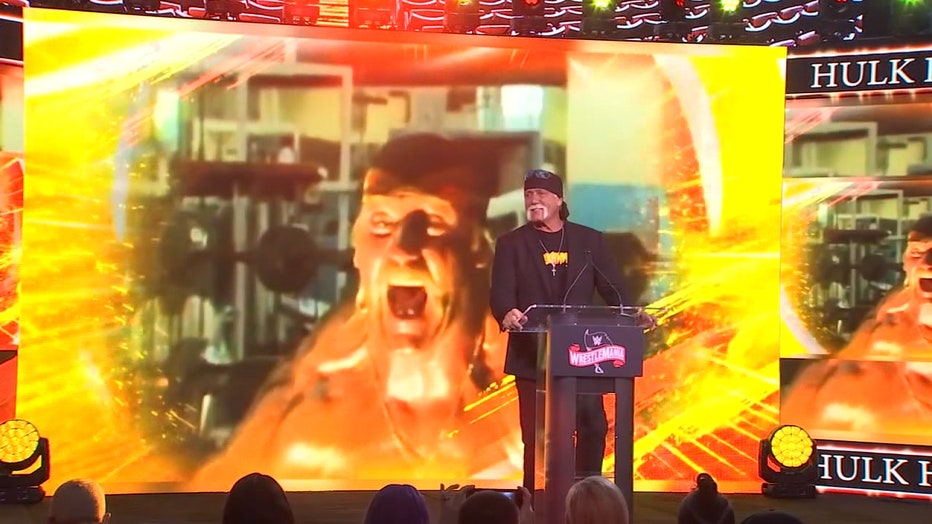
Terry Bollea, a.k.a. Hulk Hogan, shares his excitement of bringing WrestleMania 36 to his hometown on March 7, 2019. But the following year, city and WWE officials were forced to cancel those plans due to the pandemic.
Tampa was supposed to host its first WrestleMania event in 2020. When WrestleMania 36 was announced, WWE chief brand officer Stephanie McMahon said, "It’s amazing to me that we haven’t been here."
But the pandemic forced the organization to cancel and move the event to its performance center in Orlando with no live audience.
However, it turned out Tampa just had to wait another year for the opportunity.

Titus O’ Neil reflects on winning WWE Warrior Award, ready to host WrestleMania
Tampa hosted the Super Bowl. Two months later, it's hosting the ‘Super Bowl’ of professional wrestling with one of its own residents hosting – Titus O’ Neil.
"I’m happy that the WWE decided to come back," Dr. Massey said. "In a lot of ways, I think Tampa is WrestleMania’s rightful place because Tampa does have such a rich wrestling history. I think it’s great. I think the community is really excited."
As for the NWA, it's now its own national promotion and remains one of the oldest professional wrestling organizations in the world.
The historical information in this report was provided by the Tampa Bay History Center and WWE.

